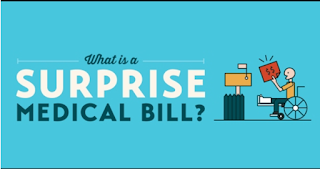Many of America’s citizens consider their country one of the most advanced in the world. Despite this advancement, healthcare in the U.S. has sunk to 27th in the world (Business Insider). Unexpected medical bills for many families in the U.S. are problematic because they have no way to address them. The ongoing novel Coronavirus ("COVID-19") pandemic only exacerbates it.
Recent statistics revealed 35% of adults in America are worried about unexpected medical bills, with 22% worried about both health insurance and prescription drug costs (KFF).
 |
| Photo Source: Center for Public Policy Priorities |
Out of network providers are often the culprit of these surprise medical bills for insured citizens. According to KFF Health Tracking Polls, 65% of the public say they are somewhat worried about unexpected medical bills. 35% say they are extremely worried.
With the recent spread of COVID-19 to Europe and America, questions have been raised about the affordability of testing and treatment of the virus.
Families who work hourly for family income are extremely susceptible to surprise medical bills in relation to COVID-19. With quarantines, restaurant shutdowns and other businesses suspending operations in light of the pandemic, many are left without work, and subsequently without an income.
Most all U.S. insurance companies have agreed to cover costs of COVID-19 testing and treatment, but those who are uninsured and in a high-risk category such as HIV positive persons are at the mercy of the healthcare system.
One Miami resident checked himself into the hospital after a work trip to China, for fear of possible exposure to the virus.
“He asked to be first tested for the flu before getting a CT scan to screen for coronavirus because of his limited insurance plan. He did have the flu, which meant no further testing for coronavirus, but he told us that the whole hospital visit cost $3,270, according to a notice from his insurance company,” (Business Insider).
A trip for the flu is upwards of $3,000 for the average person. A person who visits the ER with moderate severity to high severity of COVID-19 could face hospital bills ranging from $441-$1,151. A bill this high and unexpected could set back the average American citizen for months.
For insured persons, out of network costs could cripple even the most financially secure families. Jennifer Finney Boylan is a contributing opinion writer for the New York Times recently wrote on her $145,000 surprise medical bill, due to an out of network provider. (New York Times)
“I contacted our doctor the day after we got our $145,000 bill and he very kindly told me not to worry. “Doctor’s orders!” he added, which I thought was nice. Later, another doctor in the practice told me that even when procedures are pre-authorized (as my child’s was) insurers often deny them anyway. His understanding was that insurance companies often respond to preapproved claims with denial and delay, hoping that consumers will somehow just give up,” Boylan said.
While surprise medical bills may knock American citizens off their financial track for a while, Boylan’s story proves that some are repairable. With the inevitable spread of COVID-19 through the U.S. in the upcoming months, hopes of many are that out of network costs will be waived to fight the virus and help the more financially fragile of us all.
References:
- Bendix, A. (2018, September 27). The US was once a leader for healthcare and education - now it ranks 27th in the world. Retrieved from https://www.businessinsider.com/us-ranks-27th-for-healthcare-and-education-2018-9
- Boylan, J. F. (2020, February 19). My $145,000 Surprise Medical Bill. Retrieved from https://www.nytimes.com/2020/02/19/opinion/surprise-medical-bill.html
- Hoffower, H. (2020, February 29). Coronavirus testing is free, but the hospital trip may set you back thousands. One graphic breaks down potential costs. Retrieved from https://www.businessinsider.com/how-much-does-coronavirus-treatment-cost-cdc-health-insurance-2020-2
- Lopes, L., Kearney, A., Hamel, L., & Brodie, M. (2020, February 28). Data Note: Public Worries About And Experience With Surprise Medical Bills. Retrieved from https://www.kff.org/health-costs/poll-finding/data-note-public-worries-about-and-experience-with-surprise-medical-bills/?utm_campaign=KFF-2020-Health-Costs&utm_source=hs_email&utm_medium=email&utm_content=84040903&_hsenc=p2ANqtz-9QXfClhIkboujL5y5GF7evYHuGhjVSsvRW9KkkIH0tEGYuc7-VaNrvabHd3r-GyjNBOLUJOKsL8fDWEhhoQxixWSJ9DQ
Disclaimer: Guest blogs do not necessarily reflect the views of the ADAP Advocacy Association, but rather they provide a neutral platform whereby the author serves to promote open, honest discussion about public health-related issues and updates.

No comments:
Post a Comment